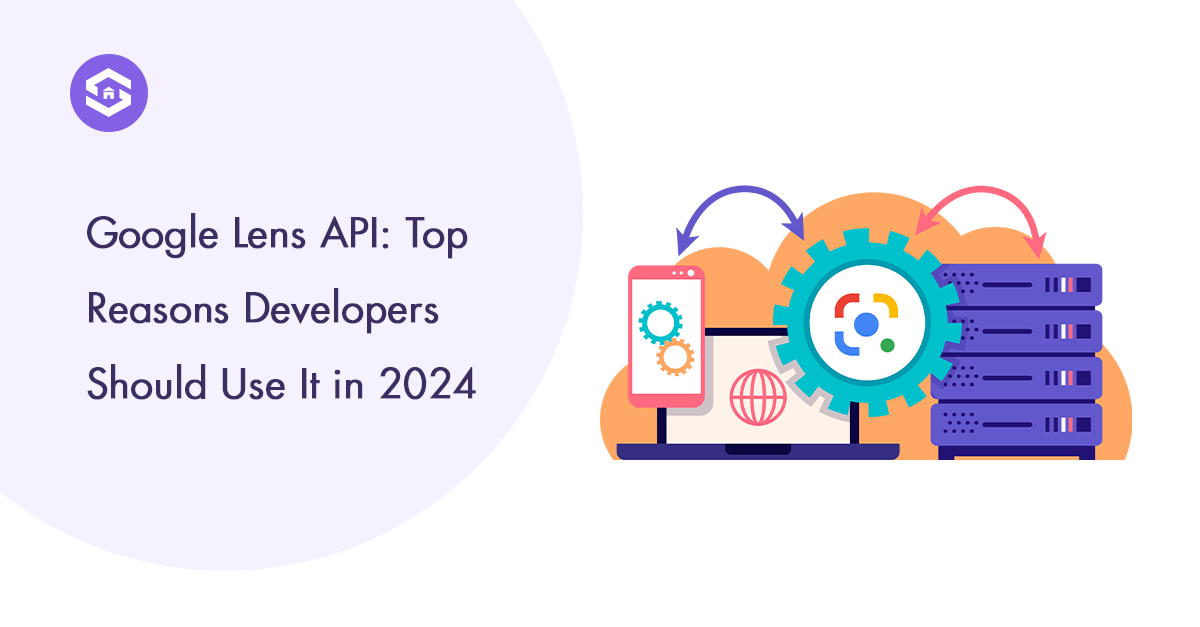Top Benefits of Google Lens API for Developers in 2025
7 min read
7 min read

Table of Contents
Table of Contents
In today’s rapid-paced tech world, image recognition and visual search technologies have rapidly advanced, with developers looking to integrate smarter, more intuitive capabilities into their applications. One of the most powerful tools for developers in this space is the Google Lens API. As we appear ahead into 2025, this API affords endless possibilities to transform applications by allowing users to interact with their environment innovatively.
In this blog, we can discover the top advantages of using this tool, how it enables developers to enhance user experiences, and the impact it can have on app functionality.

One of the most significant of using the Google Lens API is how seamlessly it integrates with existing applications. The API offers a developer-friendly interface, making it simpler for coders to put into effect while not having to create complex image-recognition structures from scratch.
By reducing the attempt required to integrate visual recognition skills, developers can focus on building their apps’ core features, reducing development time and costs. Whether it’s an educational app that needs to recognize text, this API simplifies the process. For retail apps requiring product identification, the integration is equally straightforward.
The ability to recognize and interpret text or objects within images is a core feature that benefits any app relying on visual input. The Google Lens API allows developers to include powerful text extraction capabilities, enabling users to capture written information from physical sources, like business cards, posters, or restaurant menus, and translate it into editable digital textual content.
In addition to text popularity, the API can identify real-world objects and provide context. This is especially useful for e-commerce apps, educational tools, or travel apps. Users can simply point their camera at an object and instantly retrieve relevant information about it. These capabilities make apps more dynamic and enhance the overall user experience by delivering valuable information quickly and accurately.
With worldwide connectivity at an all-time high, the demand for applications with multilingual capabilities has increased. The Google Lens API includes a built-in translation function that may recognize and translate text from one language to another in real-time.
This functionality is beneficial for a journey or language-learning app in which users can also want to interact with content in different languages. Imagine a visitor who uses an app to experiment with an avenue sign written in a foreign language and immediately receives a translation. By incorporating these features, developers can make their apps more globally reachable and relevant to a broader audience.
Augmented Reality (AR) is another area where the Google Lens API shines. By enabling apps to recognize real-world objects, developers can enhance user interactions. They can also overlay digital information, creating more immersive and engaging experiences. For example, in an interior design app, users could point their camera at a piece of furniture, and the app could suggest other complementary pieces or display pricing and availability.
This feature brings an interactive dimension to mobile applications, transforming how users interact with the physical world through their devices. The ability to enhance AR experiences also makes apps more engaging and visually appealing.
One of the often-overlooked benefits of the Google Lens API is the ability to customize data collection. Depending on the app’s purpose, developers can tailor the API to extract the specific types of information they need from images. Whether it’s text-based information, object details, or geographic data, developers can fine-tune the API to meet their unique needs.
For example, an app focused on agricultural development might need to recognize various types of crops or plants. A social media app, on the other hand, could use the API to categorize visual content. This would be based on the images uploaded by users. This level of customization makes the tool versatile for various industries.
For developers working on SEO-driven platforms, the Google Lens API offers a new way to boost search results and optimize content. Visual search is rapidly growing in popularity, and apps that can analyze and retrieve information from images are in high demand.
By integrating this API, developers can help users find products, services, or content more effectively through visual data. It’s ideal for e-commerce platforms, allowing users to search for products by uploading an image. This eliminates the need for text-based searches altogether.
One of the most important aspects of modern app development is ensuring that apps are accessible to a diverse group of users, including those with disabilities. The Google API supports this by enabling features like voice-assisted recognition for users who may have difficulty reading or interpreting visual content.
For instance, an app designed for visually impaired users could use the API to scan and interpret text or objects, and then relay that information through audio feedback. This not only broadens the app’s reach but also fulfils an important need for inclusivity in technology.
When integrated into apps, the Google Lens API provides valuable data-driven insights. Developers can track how users are interacting with images, what they are searching for, and which objects or text users are engaging with the most. These insights can be instrumental for businesses aiming to refine their product development strategies or marketing efforts.
Understanding what users are looking at in real time gives companies a significant edge in personalizing content and improving user satisfaction. Developers can use this data to continuously update and optimize their apps, ensuring they meet evolving user needs.
One of the key advantages of using a tool developed by Google is the regular updates and improvements it receives. The Google Lens API is no exception to this, consistently evolving to meet user needs. Google continually refines its APIs to ensure they stay at the cutting edge of technology. This means that developers using the API can expect new features, improved accuracy, and even better integration as time goes on.
In 2025, staying competitive in app development requires leveraging tools that are regularly enhanced, and Google’s commitment to improving its API services is a significant advantage for developers.
Incorporating advanced image recognition capabilities requires significant investment, either in developing the technology from scratch or licensing expensive third-party software. However, the Google Lens API offers a cost-effective solution by providing these powerful features at a fraction of the cost.
For smaller developers or startups, this is particularly beneficial. It provides access to advanced features without requiring a large budget. This levels the playing field, allowing smaller companies to compete with larger firms.
The Google Lens API offers developers a wide range of benefits, from enhanced user experiences and powerful image recognition features to advanced localisation and translation capabilities. By integrating this API, developers can create smarter and more efficient applications. These apps will be able to meet the increasing demand for advanced visual search and recognition features.
As we move further into 2025, the ability to incorporate such features is no longer a luxury but a necessity for staying competitive in the app development space. From cost-effectiveness to accessibility, the Google Lens API provides all the tools developers need to create innovative, engaging, and globally relevant applications.
The Google Lens API allows developers to integrate visual recognition capabilities into their applications, enabling users to identify objects, text, and landmarks through images.
The API provides enhanced user engagement by allowing apps to offer visual search features, object recognition, and image analysis, improving the overall user experience.
Key features include text recognition, object detection, image labeling, barcode scanning, and real-time visual search capabilities, making it versatile for many use cases.
Yes, educators can use the API to create interactive learning experiences, allowing students to identify objects and access related information instantly.
Google Lens API adheres to Google’s security standards, ensuring data protection and privacy for both developers and end users when implementing visual recognition features.